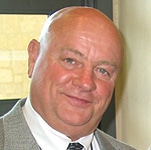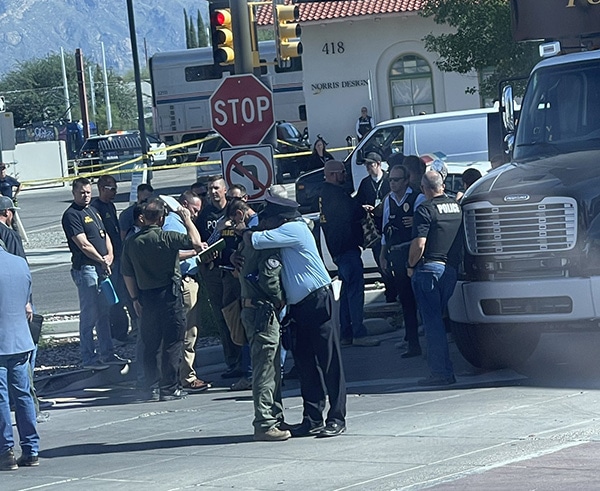A DEA officer was killed, as was a suspect, and two other law enforcement officers were wounded when gunfire erupted inside Amtrak’s Sunset Limited train the morning of Oct. 4 while it was stopped at the Southern Arizona Transportation Museum in Tucson.
One suspect was in custody, according to media reports, and none of the 137 passengers or 11 crew members aboard the train were injured in the incident, which authorities said was precipitated by a routine search for illegal contraband and drugs aboard the train.
Video of the incident as it happened was captured by a live railfan cam at the museum station.
Terrence Dicks, a 20-year member of our union and a member of Local 84 (Los Angeles, Calif.) who was the conductor on the train when the gun battle happened, can be seen in a photo provided to The Associated Press and other media outlets on Twitter by passenger Evan Courtney providing comfort to a Tucson police officer who had responded to the scene.
The identities of the slain DEA agent, the injured officers nor the suspects were not released at the time of this article’s publication.
“We express our most heartfelt sorrow to the law enforcement brothers and sisters of the DEA agent who was killed in this senseless act of violence, and we wish for rapid recoveries for the two wounded officers,” said SMART Transportation Division National Legislative Director Gregory Hynes. “We also express relief that the incident in Tucson did not result in additional casualties among the passengers and crew who were aboard the train.
“But that such an incident happened during a routine stop and search exposes a great flaw in the security measures currently used on our nation’s passenger rail system. We again call upon Congress to enact measures that bring the level of security screenings aboard the nation’s passenger trains to where they are in the nation’s airports.”
SMART-TD initially called for such measures by federal agencies soon after the Jan. 6, 2021, insurrection at the nation’s capital.
Tag: Department of Homeland Security
U.S. Senator Chuck Schumer (D-NY) is asking the Dept. of Homeland Security to “immediately step in to enforce a recommendation” made years ago to screen mass transit employees against federal terror watch lists. Read the complete article from abcnews.go.com.
The Department of Homeland Security has been ordered by a federal district court in Nebraska to cease assessing fines against Union Pacific and seizing its rolling stock following discovery of illegal narcotics on trains originating in Mexico and delivered by Mexican railroads to UP at the Mexican border.
The court said U.S. Customs and Border Protection — an agency of the Deparatment of Homeland Security — exceeded its authority in assessing the fines and seizing the railcars in which the illegal narcotics were found.
UP, which sued the federal government, said it had been wrongly assessed more than $37 million in fines and penalties by Customs and Border Protection after the illegal narcotics were found in rail equipment delivered to UP at the Mexican border crossings at Brownsville, Texas, Calexico, Calif., and Nogales, Ariz. The court cancelled the $37 million in fines and penalties.
Earlier this year, UP agreed to spend some $50 million to improve its border- crossing security, and to work more closely with Customs and Border Protection. UP has assigned railroad police, K-9 teams and private security contractors to its border crossings in an effort to find those narcotics when the railcars are delivered by the Mexican railroad. UP also paid to construct an office and observation towers for use by Customs and Border Patrol officers.

The UTU and the Terminal Railroad Association of St. Louis (TRRA) are jointly seeking an anti-terrorist security grant from the Department of Homeland Security (DHS).
If the grant is approved — with a DHS decision expected in August — the UTU and TRRA will collaborate on a three-year project to train front-line TRRA employees to enhance security awareness.
The project — with International employee Bruce Feltmeyer (UTU Local 1402, St. Louis) leading the UTU team — proposes joint UTU/TRRA creation of a security awareness manual, plus emergency preparedness classroom training, drills and exercises that will present various terrorist scenarios and means of recognizing, reporting and responding to terrorist threats against TRRA facilities.
The TRRA is a major railcar switching facility, with yards in downtown St. Louis and in the shadows of the Gateway Arch.
Daily, carloads of hazardous materials and other security-sensitive cargo are interchanged among most major railroads by TRRA train and engine workers. “The nature of TRRA’s operation, its importance to national rail-network reliability, and its location in the heart of a major U.S. city could make TRRA a high-priority target for foreign terrorists as well as disturbed individuals,” Feltmeyer said.
The UTU is currently working with Amtrak to develop training of conductors, assistant conductors, on-board service personnel and yard employees to enhance their abilities to recognize behavioral traits and deal with unruly passengers. That project is funded with forfeiture proceeds from federal drug-busts.
Additionally, discussions are underway with Class I freight railroads regarding joint UTU/railroad applications for federal grants to develop similar training programs for front-line Class I employees.
Feltmeyer, who is administrative assistant to UTU International President Mike Futhey, says the knowledge and understanding of vulnerability demonstrated by TRRA Police Chief George Muraski and former Amtrak Police Chief Ron Frazier will ““help to make a strong case for DHS funding of this joint UTU/TRRA project.”
At UTU regional meetings in San Antonio, Texas, and New York City in June and July, Feltmeyer will lead educational workshops on recognizing, reporting and responding to terrorist threats.
“Bruce Feltmeyer is uniquely qualified for this leadership task,” Futhey said. “During his years of rail service, he has developed training programs for the on-line UTU University; and, as a Union Pacific employee, he helped to develop customer-service related training materials for conductors and newly hired managers.
“Bruce also taught business software as an adjunct professor at a St. Louis community college,” Futhey said.
